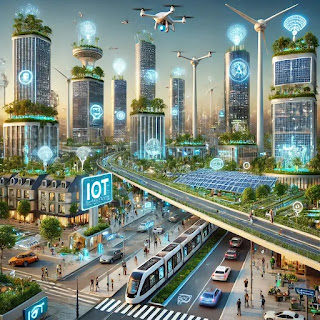The Rise of Futuristic Smart Cities: Transforming Urban Living
As the global population continues to rise, urban centers are under increasing pressure to become more efficient, sustainable, and livable. Enter smart cities—an innovative solution that merges technology, data, and design to create a future-ready urban landscape. Futuristic smart cities are more than a concept; they are rapidly becoming a reality, reshaping how we live, work, and interact.
What Are Smart Cities?
Smart cities leverage advanced technologies such as the Internet of Things (IoT), artificial intelligence (AI), big data, and automation to optimize city functions and enhance residents' quality of life. From intelligent transportation systems to energy-efficient buildings, these cities focus on sustainability, efficiency, and citizen-centric solutions.
Key Features of Futuristic Smart Cities
-
Sustainable Infrastructure: Smart cities prioritize green energy, waste management, and water conservation. Solar panels, wind turbines, and energy-efficient smart grids power urban centers while minimizing environmental impact.
-
Intelligent Transportation: Self-driving cars, drone deliveries, and smart traffic management systems reduce congestion and improve connectivity. Apps provide real-time updates on public transport, making commuting seamless.
-
Smart Homes and Buildings: IoT-enabled devices optimize energy usage in homes and offices. From automated lighting to advanced security systems, buildings adapt to occupants' needs in real time.
-
Digital Governance: Governments use technology to provide e-governance services. Citizens can pay bills, access healthcare, or report issues through user-friendly digital platforms.
-
Enhanced Connectivity: High-speed 5G networks ensure uninterrupted connectivity, supporting everything from telemedicine to virtual education.
-
Data-Driven Decision Making: Sensors and data analytics monitor everything from air quality to traffic patterns. City planners use this data to make informed decisions that benefit residents.
Examples of Futuristic Smart Cities
-
Singapore: Known for its Smart Nation initiative, Singapore employs AI, IoT, and big data to manage urban challenges. The city has smart traffic systems, energy-efficient buildings, and a focus on digital healthcare.
-
Dubai: Dubai aims to become a global leader in smart city initiatives by 2030. It’s experimenting with AI-powered police, autonomous public transport, and blockchain for government services.
-
Songdo, South Korea: Built from scratch, Songdo is often called the world's first smart city. It features advanced waste disposal systems, intelligent transportation, and eco-friendly architecture.
Challenges in Developing Smart Cities
While the benefits are immense, smart cities face challenges:
- High Initial Costs: The infrastructure and technology investments required are substantial.
- Privacy Concerns: With widespread data collection, ensuring cybersecurity and protecting citizens' privacy is critical.
- Digital Divide: Not all residents may have equal access to the technology driving these cities.
- Sustainability vs. Growth: Balancing economic growth with environmental sustainability remains a complex task.
The Future of Smart Cities
As technology evolves, smart cities will become more integrated, adaptive, and citizen-centric. Emerging trends include:
- AI-Powered Urban Design: Predictive models will plan neighborhoods to optimize space and resources.
- Carbon-Neutral Cities: Renewable energy and green initiatives will drive cities toward zero-carbon footprints.
- Personalized Experiences: IoT and AI will tailor city services to individual preferences.
Futuristic smart cities represent the next frontier in urban development, promising a sustainable, efficient, and inclusive future. As we embrace this revolution, collaboration among governments, private sectors, and citizens will be essential to ensure these cities meet the needs of tomorrow.

Comments
Post a Comment